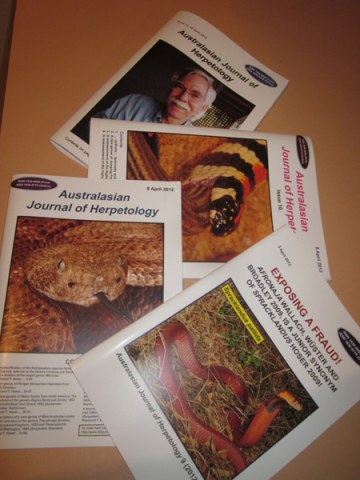Global Snake audit yields over 100 species in 25 unclassified genera.
Media release 10 May 2012
An audit of most of the world’s advanced snakes utilizing results of several molecular studies has found more than 25 genera of unassigned or improperly assigned snake species.
In a series of papers published last month in issues 10-12 of Australasian Journal of Herpetology, over 110 species of snakes were shown to have been placed within genera they were not phylogenetically a part of.
As a result, Australian zoologist Raymond Hoser assigned the relevant species to more than 25 new genera in a series of recently published papers. At the same time several undescribed species were formally named for the first time.
Honoured in having snakes and genera named after themselves included various well-known herpetologists and others.
Snakes assigned to new genera included species on every inhabited continent, including Europe, South America, Madagascar, Australia, New Guinea and Japan. The areas with most unassigned snakes were south-east Asia and quite surprisingly, North and Central America.
While most of the new genera are small in numbers of species or even monotypic (one species only), some are actually quite large with one newly named genus of American Coral Snakes consisting of over 40 species, which happens to include all the species found within the United States!
As to why some areas had a lot of unassigned species and others such as Australia didn’t, the snake man Raymond Hoser had a simple explanation.
“The molecular methods used to identify snake genera accurately is relatively new. In some places, notably Australia, Africa and to a lesser extent South America, there are individual herpetologists who have in recent years aggressively sought out and formally named any unassigned groups of species meaning there were less unnamed ones found by this audit. In the North America, the perception for some years had been that everything there was known so a lot of species had been ignored for a long time by the local herpetologists. Meanwhile molecular studies not available just decades ago had revealed deep divergences within groups thought to be monophyletic.”
Species of snakes assigned to new genera include Pitvipers, True Vipers, Colubrids, Snail eaters, Mole snakes and others. In terms of Colubrids, genera split up to include newly named genera include Thamnophis, Nerodia, Regina, Boiga, Dendrelaphis, Lampropeltis, Natrix, Coronella, Coleognathus, Rhadinophis and Xenochrophis.
Issue 9 of the journal shows that the 2009 reclassifications of various species including Rattlesnakes were published in accordance with the Zoological Code, which is at variance with widely disseminated false claims made late in 2009 to the effect that AJH was only an electronic journal.
The Rattlesnake reclassifications of 2009 and a similar one published this year are corroborated by recent molecular studies. The most notable change to pre-existing taxonomy is the removal of the rattlesnake species ravus into its own genus Piersonus.
The papers can be obtained either as hard copy or via the web as pdf’s from:
http://www.herp.net

